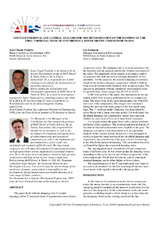| dc.description.abstract | Lecture 13: This paper deals with the damping ratio D (modal damping) of the 1st torsional mode of synchronous motor driven compressor trains. The damping ratio is a crucial parameter for the torsional start-up analysis and for the lifetime calculation of the shafts. The magnitude of the torques at resonance (and by consequence the shaft stresses) is strongly dependent on this parameter. For the analyses, the assumed damping is normally based on the authors company’s experience, which is built up from several measurements formerly done at similar trains. The data are in agreement with the commonly used standard value for geared trains, which ranges from D=2% to D=5%. In the first section of the paper, two measurements are presented, which were recently performed at two air compressor trains. The trains were of the same arrangement, but with different sizes of the components. The torques were measured during the start-up with strain gauges at the low speed couplings. The 1st torsional mode’s damping was determined by curve-fitting with a linear one-mass model. For both trains, the identified damping was considerably higher than expected. Further on, non-linear effects were observed at resonance. In a second section the paper deals with coupled torsional and lateral (T&L) analyses. The torsional and lateral degrees of freedom of the shaft train model were coupled via the gear. The damping in resonance was determined with an eigenvalue analysis of the coupled system. Herewith, it was attempted to explain at least the linear portion of the identified damping and, respectively, the contribution of the gear’s fluid film bearings to the effectively measured damping. The calculations basically confirmed the higher than expected damping ratios. The investigations were extended to several compressor trains of different sizes. It was observed that the damping varies depending on the actual inertia and stiffness proportions of the train components. The deviation from the usually employed standard damping can be either higher or lower values. The eigenfrequency of the 1st torsional mode was found to be a practical parameter for the first screening of similar compressor trains, with regard to the mode’s damping ratio. | en |


